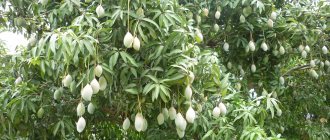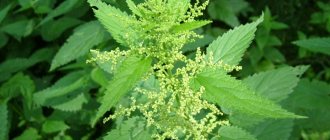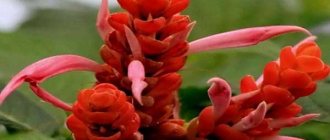Characteristics of hazelnuts
There are many types of nuts. One of the most popular is hazelnuts. Just don’t confuse it with hazel.
Hazelnuts are an unpretentious, hardy garden crop. It can grow in one place for 50–100 years. It is a perennial shrub, reaching a height of 3-5 meters. The leaves are oval or heart-shaped. The nut contains a number of vitamins A, B, C, D, E, as well as valuable nutritional elements.
It is used as a supplement for vascular diseases and a weak immune system. Hazel is widely used in the food industry. It has a high value, so many gardeners want to grow this crop on their property or at home in a flower pot. Considering the amount of harvest, planting hazelnuts can be the start of a profitable business.
One mature tree can produce up to 10 kg of fruit. But its cultivation is a labor-intensive process, so it is mainly done by experienced gardeners. The right advice will help you figure out where to start and how to care for the plant.
Hazelnut varieties are both decorative and fertile. Breeders are very interested in its development. The reasons for this are the pickiness of the culture. Ripe and tasty fruits can be grown in almost any soil.
Popular varieties among gardeners
There are many varieties of hazelnuts. Some are used for industrial plantings, others are grown on their own plots for decorative purposes. It is planted in open ground mainly in the south of Russia. But many species are adapted and adapt well to different climates. The most popular varieties are Kudryavchik, Adygeisky, Borovskoy, Trebizond.
Barcelona and English Cosford
The height of the Barcelona view is up to 5 meters. Nuts are distinguished by their large size, hardiness, frost resistance and productivity. The color of the fruit is red-brown. They are juicy and tasty. A special feature of this variety is its leaves of interesting color. The top is a richer shade than the bottom. There is a drawback - it is susceptible to moniliosis.

English Cosford has dark green leaves that turn red in autumn. The crown is dense. Ripening time is September. The rounded and flattened shape of the nut distinguishes the variety. Juicy and tasty, quite buttery. Does not like windy growing areas. If the conditions are met, fertility is good.
Kudryavchik and Crimean Trebizond
The ripening period for Kudryavchik is early. Contains from 3 to 15 nuts in one bunch. The shell is hard, fits tightly, and is twice its size. The fruits have a rounded-wide shape, the apex is pointed, the base is tuberous or ribbed. The species grows well and produces a bountiful harvest.
Purified kernels are easily obtained. The fruit is strong, smooth, appetizing, it contains oils and protein compounds. Full ripening occurs in August. Suitable for growing in central Russia, resistant to pests and weather changes.
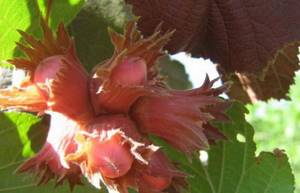
Crimean trapezund is the most common type of hazelnut with a kernel yield of 60%. Ripening time is the end of August. Nuts contain a high percentage of fat - 72%. Can withstand temperatures down to -32°C. The variety is characterized by high yield.
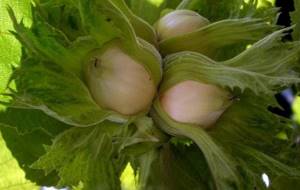
Hazelnuts require space. The bush will not be able to develop on a small piece of land. Grows up to 3–5 meters. It is worth taking this into account when choosing a landing site. He is not attracted to the shadow. The higher the lighting, the better the yield. Wind and drafts should be avoided.
Redleaf and European
This is a whole group of varieties. They are united by the color of the leaves. Carmine shades are incredibly beautiful. Used for decorative purposes. They are favorites of many gardeners and are suitable for growing in the country. They are characterized by increased frost resistance. They tolerate harsh winters, which is very convenient for the Russian climate. High-yielding.
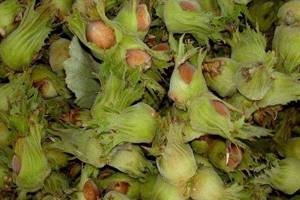
You can choose the variety that suits you best and suits your area. Pay attention to mutual pollination and compatibility, this will increase the yield. Since the plant is massive, you should consider the planting location.
Adyghe hazelnut
One of the most popular varieties for growing in the south. Characterized by early ripening. Ripe fruits are harvested in August. Among the advantages, gardeners note good resistance to frost, dry soil, and pests. Productivity is 12–15 centners per hectare. The purpose is universal. Can be grown for sale, for industrial production or personal use. The taste of the fruit is harmonious. Coffee shell, thin. Suitable for growing in open ground.
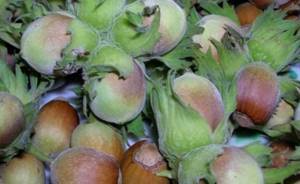
The bush has a crown of medium density and pubescence, the shoots are yellow-olive in color. The fruits are wide-round in shape, collected in bunches of 4–5 pieces. The shell is whole, larger in size than a nut. The taste is pleasant, gently sweetish, tart. One hazelnut contains 65.6% fat, the kernel yield is 49%. The Adyghe variety was added to the state register in 1973. Today there is a type of folk selection - the Cherkessk variety.
What does hazel look like?
According to descriptions of the culture, which are found in various sources, most types of hazel belong to shrubby deciduous plants. The foliage is round in shape and relatively large in size compared to other types of bushes. The crown of the hazel tree is bright green, making the plant stand out from other trees and bushes.
Hazel, which grows where it is warm and humid, gives good growth and a rich harvest. It is very important that it is in fertile soil. Hazelnuts love proximity to trees such as:
- oak;
- ligature;
- maple.
Wild hazel forms a continuous wall in the undergrowth. It is formed from a large number of branches and stems that the hazel tree produces directly from the rhizome. Hazel has several features. Among them:
- The height of one bush reaches from 3 to 5 meters.
- Hazel propagates by suckers and cuttings. This is called the vegetative method. The plant is also propagated using hazelnut kernels, which are also seeds.
- If seeds are chosen to propagate the plant, then the first harvest will occur no earlier than in 6-7 years. Therefore, to speed up the process, it is better to choose a vegetative method for hazel propagation. In this case, you can get fruits from the bush after 4 years.
- In the forest, hazel is difficult to confuse with other plants. It is decorated with leaves, along the edges of which there are small teeth. Each leaf has a sharp tip and a slightly rough surface.
Under favorable weather, climatic and other external conditions, the cultivated plant grows into a fairly large shrub. Its height averages from 5 to 6 meters. The trunk of the plant is protected by an even and smooth bark, the color of which varies from gray to brown.
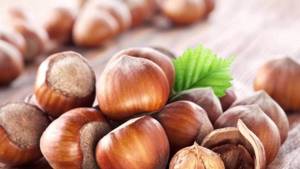
Young shoots resemble linden. The main differences between the two plants are that hazel has denser foliage and a large number of branches are formed at once, which immediately emphasize that they belong to shrubs. The trunk of the plant is colored gray-green. Small patches of yellow color may appear on it.
Reference!
Hazel also has another distinctive feature. We need to pay attention to his kidneys. They are oval and gray-green in color.
Soil selection and fertilizing
Walnut grows almost everywhere except swamps. It is not attracted to sandy and saline soil types. The more fertile the soil, the more abundant the harvest. A loose substrate with a neutral environment will be optimal. Don't forget the nutrients. Peat or sand is suitable for black soil.
Various mineral additives will improve moisture and breathability. Avoid heavy and compacted soils, as well as cold ones. Planting on slopes is possible. The superficial root system makes it possible to strengthen such a substrate. However, not all places are suitable for landing. Too large ones need to be traced. Despite the fertile soil, if there are weeds on it, they interfere with the development of plants. If there are large quantities, they should be removed.
Different fertilizers are used for different soils. Both upon landing and in the future. Manure, humus, and wood ash are used. As well as fertilizers intended for fruit crops, including mineral ones. Select fertilizer according to your soil type and age of the bush.

To improve the absorption of nutrient components, each gardener uses his own techniques. Basically, the soil is carefully loosened, trying not to damage the roots, since they are close to the surface. An adult plant can be mulched and pruned to renew the bush and protect the crop from pests.
Rules of care
For full development (this is especially important for a young plant), you need to properly care for it, and do not forget about regular feeding and watering. For hazelnuts, the pruning procedure is very important, since the bush grows very much, and the branches interfere with each other very much.
Loosening and weed control

Hazel, like any other garden crop, loves loose soil that is free of any weeds. In this regard, it is necessary to loosen the soil around the bush quite often and remove all existing weeds, especially in young and just emerging hazelnuts.
It is also necessary to take into account that the rhizome of hazel is located quite close to the surface, literally 15 centimeters from it, so you need to loosen it with extreme caution. But for an adult bush, these procedures can be carried out less frequently, since they harm the powerful root system much less. You can completely replace these measures with mulching, which protects the roots from freezing and leaching out moisture.
Watering and fertilizing
Since hazel is very moisture-loving , watering procedures must be carried out quite often and abundantly. This especially needs to be taken into account in the summer, since this is when the planting of the future harvest takes place. Watering work is carried out based on weather conditions: if the weather is dry, then you need to water once every two weeks. Irrigation systems have proven themselves to be excellent, so if desired and lacking time, you can use them.
Overwatering can harm the bush, causing root rot. That is why, when planting, a good drainage layer is laid in the hole, which will help avoid troubles of this kind. If young bushes are watered, it is better to use rainwater or well-settled water. Do not use ice water - it can harm the bush.
Fertilizers are important for good growth and fruiting. What kind of composition to apply and how often it needs to be done depends entirely on the quality of the soil itself. As a rule, the following fertilizers are applied to the soil annually:
- humus;
- compost;
- wood ash;
- peat.
At the beginning of summer, when the laying of nuts begins, it is necessary to feed the hazelnuts with urea (0.5%). Mineral supplements also have a beneficial effect on fruiting. But it is better to add organic matter while digging the earth around the bush.
If the soil in the garden plot is in good condition and contains a sufficient amount of organic matter, then nitrogen fertilizing should not be carried out. The fact is that this can provoke active growth, and this, in turn, will reduce the yield.
Bush formation and pruning
A correctly formed and pruned plant will grow more actively, develop more fully, and accordingly, the fertility of such a bush will be increased. In addition, the pruning procedure also affects resistance to various diseases, and a pruned bush withstands wintering much easier than an untouched one. For this reason, annual pruning is extremely important.
There is a standard and bush form of pruning, the purpose of both is to design the bush in such a way that air and light easily penetrate through the foliage and branches, as well as to stimulate the growth of new branches. Such activities should be carried out either before the growing season or in late autumn.
To get a beautiful lush shrub, you need to cut off all unnecessary, improperly growing and old branches so that only 7-8 of the strongest trunks remain on the bush. It is necessary to form such a bush before the moment when the hazel tree begins to bear fruit, that is, within five years.
After the shrub reaches four years of age, its shoots will begin to actively develop. If they are removed, the bush will form a single trunk, which will have a tree-like shape. If you want to have a hazel tree in the form of a bush, then you need to remove all unproductive shoots and leave young and healthy branches intact. The most important thing is to thin out such a bush, since insufficient lighting affects fruiting and significantly reduces yield.
Older bushes require pruning for rejuvenation purposes. To do this, several old trunks are removed from the bush, and all young branches are shortened. The purpose of this procedure is to replace the old stem part with a healthier and younger stem. Such rejuvenation can be carried out gradually, or it can be done at once. In the first case, it is necessary to cut off one old trunk annually, leaving one young shoot. Do this until the bush is completely renewed. In the second case, all the old trunks are cut off at once, but in this case the hazel tree will not be able to bear fruit for several years.
Preparing for landing
It’s one thing to plant a seedling for testing or for decoration. Planting a row or more is something completely different.
The first stage of the procedure is sorting the seedlings. Some are suitable for planting, others are too small and need to be grown. Rearing takes from 1 to 3 years. To do this, seedlings are planted in a mini-garden.
Hazelnuts are a long-term crop. If you plant shrubs too close, they will interfere with each other's growth. A distance of 4–5 meters between them is optimal. The row spacing is 5–6 meters. Walnuts are often planted for decoration. To do this, maintain a distance of 2–3 meters.
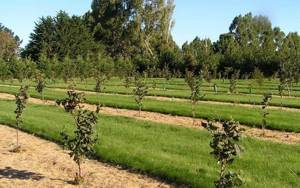
Hazelnuts are mutually pollinating, so you shouldn’t plant just one variety. It is advisable to use three or more types. A good pollination option is hazel. One such crop is planted per 10 rows.
Planting hazelnuts
Prepare your seat in advance. The hole is prepared 1–3 months before planting. Humus, potassium sulfate and double superphosphate are added to it. Then you should mix everything with the soil. The size of the hole is 70 by 70 cm. You need to make a mound in the hole and plant a bush, straightening the roots.
Then the planting is sprinkled with substrate and compacted. After the procedure, you cannot water the plant from above. It is necessary to moisturize at the root. An option for mulching tree trunk circles is possible. This is necessary to retain moisture. Use sawdust, dry grass, peat. Watering should be repeated after a week.
Experienced experts recommend planting the crop in the fall. The most favorable month is called October. Then the soil is still warm and moist. After diving into open ground, it takes time to restore the root system. Then you can do the growing season. Early spring is suitable for planting.
Features of cultivation
In order for the bush to develop correctly and fruiting to occur much faster, you need to provide the plant with ideal conditions, choose a suitable place and plant it correctly. First you need to choose a place, taking into account some nuances, namely:
- When choosing a place, you need to understand that the walnut bush grows quite quickly and after a short time the bush becomes quite spreading, so it needs space. The area should also be open and well lit. The more sunlight there is, the better the yield will be. In addition, drafts adversely affect hazel, so it is better to choose a place protected from them.
- When planting hazelnuts, you can use almost any soil; it is not so important for shrubs. The main thing is that these are non-sandy and swampy types of soil. Although it will develop much better on a nutritious and fertilized substrate. It is best to select loose and neutral soil. Soil that is highly acidic must first be neutralized by adding lime; 0.5 kg of lime is needed per 1 sq. m. If the site has black soil, it is recommended to add sand to the planting hole - this will make the soil more air- and moisture-permeable.
- Considering that the walnut bush is a moisture-loving crop, it is better to choose a place near a pond. You can also plant a seedling even in soil with groundwater.
- It is best to carry out planting work in the autumn. The ideal month for this would be October, but the weather should be warm and humid. This is due to the fact that already in the spring the roots of the hazel tree will be completely restored, which means it will be completely ready for the beginning of the growing season.
It is not forbidden to plant a tree in the spring, but then it is necessary to provide the young plant with sufficient moisture, since the root system quite quickly wastes all the moisture reserves that have accumulated over the winter period.
At the very beginning, in the area where the hazel tree is to be planted, it is necessary to carry out plantation plowing of the soil, then it is carefully leveled and divided into several planting holes. The holes for the seedlings are made in sizes 30/30/30. Immediately before deepening, you need to carefully examine the planting material and roots, remove all rotten or dry roots. Everything is cut out down to the healthy area.
The rhizome cannot be severely pruned as this can harm the plant. Initially, a wooden stake or a thick stick is installed in the hole. And the root system itself is laid in the prepared hole in such a way that the recess is 5 centimeters deeper than it was in the nursery. The young seedling is planted in a hole and covered with soil, periodically compacting the soil so that the seedling holds firmly in the ground. After this, a small hole is made near the transplanted hazel tree for watering; about 25 liters of water must be poured into each hole, and when it is completely absorbed, it must be mulched.
Plant propagation
Depending on the variety, hazelnut propagation is carried out using the vegetative method and seeds. The first method is carried out by dividing the bush. In this case, it is divided into parts. The root must remain intact. The resulting seedling takes root well. Rhizome shoots are formed in the third year. She is separated with an axe. You can propagate the nut by layering. One shoot will produce 5 layerings.
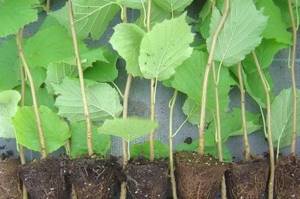
This is a labor-intensive but effective method. Layers are laid horizontally or vertically in early spring. If this method is difficult, then you can try propagation by vaccination. Plant the crop in the spring.
Seed propagation is used by breeders when developing new varieties. To begin with, whole, ripe nuts are selected and planted in the beds. They begin to bear fruit later than hazelnuts grown from seedlings. Therefore, gardeners rarely use this technique. It may take 6–10 years for the plant to bear fruit.
Planting care
With a dense crown, insects attack the trunk or leaves. Due to its thickness, this is not visible, so annual shaping is a mandatory procedure. Diseased foliage is cut off. After the cuts heal, the culture fully adapts and begins to actively grow and bear fruit.
The main requirement for caring for hazelnuts is lighting and location of the bush. Most often, the eastern and western sides are suitable for planting.
The plant's access to sun and air is important. To make the bush breathe easier, unnecessary shoots are cut off. When forming the crown, the main trunks should be preserved. If the plantings are already old, you can carry out rejuvenation by cutting off the old trunks. The bush should not be very dense.
Harvest and storage
The harvest is harvested in the fall. The first fruits can be obtained after pruning for 3–4 years. Therefore, if you planted seedlings and they do not bear fruit the first or second year, then you should not worry. When the nuts are golden brown and easy to peel, they are ready to be harvested. Dry them first, then peel off the leaf wrapper and dry again.
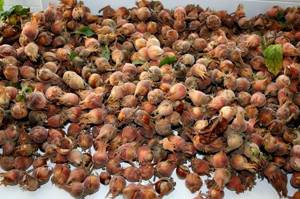
You can store hazelnuts in bags or boxes. Choose a dry place. Then the shelf life is up to 3 years. Each mature tree produces 5–12 kg of fruit. Their benefits are invaluable.
What trees grow next to hazel
A plant such as hazel will completely suppress the following types of trees:
- apple tree;
- peach;
- pear;
- plum
If you plant them in close proximity to each other, then literally after 2-3 years the above-mentioned specimens will begin to dry out.
As the practice of gardening farms shows, any nut crops should not be grown next to other fruit plants. They have very low compatibility.
The most correct option is to grow several varieties of nuts in one area, especially since the form in question necessarily needs pollinators (when planting a single plant, you don’t have to expect a harvest at all). In principle, if you plan to make a decorative flower bed when planting a garden, then you can plant pine, spruce and sea buckthorn at a distance of 5-6 m from the hazel.
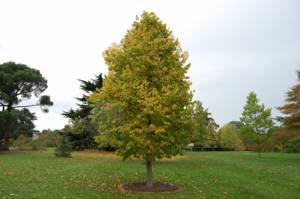
The nuts of the variety in question will tolerate such a neighborhood normally, since it is natural (wild forms of hazelnuts grow in coniferous and mixed forests in close proximity to these specimens).
Diseases and pests
Nuts are loved not only by people, but also by insects. The most common:
- Nut weevil.
- Longhorn beetle.
- Caterpillars.
Pests are extremely disruptive to growing because they feed on the life sap of the plant. To get rid of them at the initial stage, you should treat the plantings with a soap or tobacco solution according to the scheme. Larvae and other insects cannot tolerate these odors.
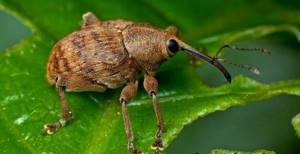
When a plant is heavily attacked, there are various means to combat them. The most effective are insecticides. To rid your plantings of insects, you need to choose the right product. The treatment is carried out in the spring, as soon as the beetles appear, in order to prevent egg laying. If you see spider mold, which subsequently turns black, this means that the hazelnuts are affected by powdery mildew. Destroy all attacked leaves. Colloidal sulfur is well suited for this purpose. Use the drug strictly according to the instructions. If it is not there, then you can replace it with a solution of lime and sulfur.
